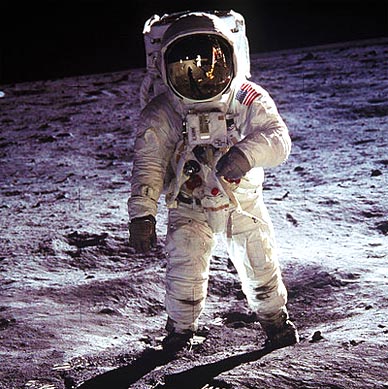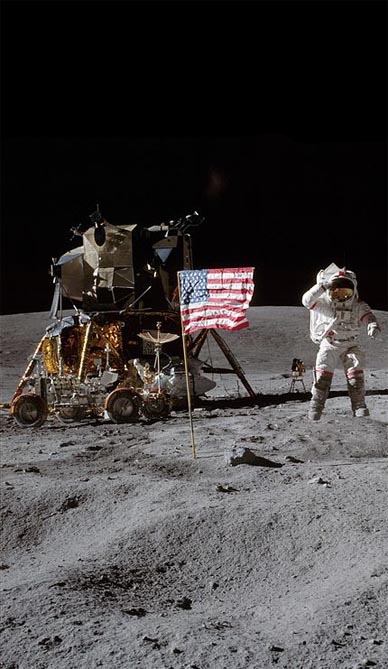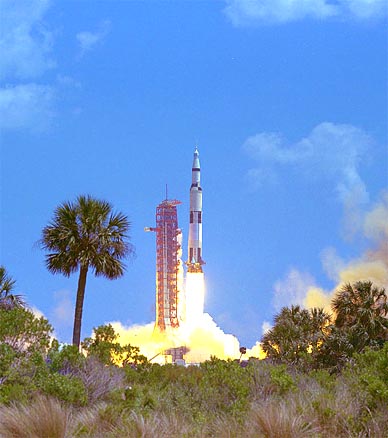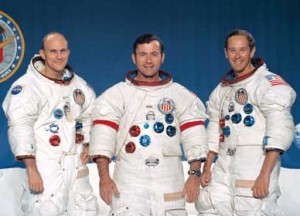APOLLO 16: An Interactive Experience
By Space Coast Daily // October 15, 2013
an astronaut's eye view from the Rover
ABOVE VIDEO: The Apollo program (or Project Apollo) was a project by the United States’ National Aeronautics and Space Administration (NASA). The goal was to send a human to explore the Moon and bring him home to earth safely. It was started by U.S. President John F. Kennedy in 1961. The first person to walk on the Moon was Neil Armstrong of Apollo 11 on July 20, 1969.
BREVARD COUNTY, FLORIDA — The film, “Astronauts: John W. Young, Thomas K. Mattingly, II and Charles M. Duke, Jr.,” shows the landing, and the three lunar traverses in the highland region of the Moon, near the crater Descartes.

This video includes an astronaut’s eye view from the Rover, lunar Grand Prix, discovery of the house-sized rock, lunar lift-off, and EVA 173,000 miles above the Earth.
Microphones and cameras in Mission Control record the emergency problem solving during the pre-landing crisis and the reactions of scientists on Earth as the astronauts explore the Moon.
Apollo 16 was the 10th manned mission in the United States Apollo space program, the fifth and penultimate to land on the Moon and the first to land in the lunar highlands.
The second of the so-called J-missions, the mission was crewed by Commander John Young, Lunar Module Pilot Charles Duke and Command Module Pilot Ken Mattingly.
Launched from the Kennedy Space Center in Florida at 12:54 PM EST on 16 April 1972, the mission lasted 11 days, one hour, and fifty-one minutes, and concluded at 2:45 PM EST on April 27, 1972.
John Young and Charles Duke spent 71 hours—just under three days—on the lunar surface, during which they conducted three extra-vehicular activities, or moonwalks, totaling 20 hours and 14 minutes. The pair drove the Lunar Roving Vehicle (LRV), the second ever produced and used on the Moon, a cumulative distance of 26.7 kilometres (16.6 mi).

On the surface, Young and Duke collected 95.8 kilograms (211 lb) of lunar samples for return to Earth, while Command Module Pilot Ken Mattingly orbited in the Command/Service Module above to perform observations.
Mattingly spent a total of 126 hours and 64 revolutions in lunar orbit. After Young and Duke rejoined Mattingly in lunar orbit, the crew released a sub-satellite from the Service Module.
On the return trip to Earth, Mattingly performed a one-hour spacewalk to retrieve several film cassettes from the exterior of the Service Module.
The decision to target the Apollo 16 lunar landing for the highlands region of the Moon was made to obtain samples of the Descartes Formation and the Cayley Formation.
Geologists believed prior to the mission that both of these formations were volcanic in origin; however, samples returned from the lunar surface have since proven this hypothesis is incorrect. Three of the first four landings in the Apollo program landed in the lunar maria; the fourth was in the vicinity of Mare Imbrium.
Accordingly, highest priority was given to a highlands site that would allow the astronauts to sample material older than the impact that formed the Imbrium basin…

The Apollo 16 mission successfully launched from the Kennedy Space Center in Florida at 1254 PM EST on 16 April 1972…
The Lunar Module Orion, with Young and Duke inside, landed 270 m (890 ft) north and 60 m (200 ft) west of the planned landing site at 104 hours, 29 minutes, and 35 seconds into the mission, at 22335 UTC on 21 April…
The next morning, flight day five, Young and Duke ate breakfast and began preparations for the first extra-vehicular activity (EVA), or moonwalk, of the mission… Young descended the ladder and, upon setting foot on the lunar surface, became the ninth human to walk on the Moon…

The pair’s first task of the moonwalk was to unload the Lunar Roving Vehicle (LRV), along with other equipment, from the Lunar Module…
They reentered the LM 7 hours, 6 minutes, and 56 seconds after the start of the EVA. Once inside, they pressurized the LM cabin, went through a half-hour briefing with scientists in mission control, and configured the cabin for the sleep period.
The second lunar excursion’s primary objective was to visit Stone Mountain to climb up the slope of about 20 degrees to reach a cluster of five craters known as “Cinco Craters.”
During the third and final lunar excursion of the mission, astronauts Young and Duke were to explore North Ray Crater, the largest of any of the craters any Apollo expedition had visited.











